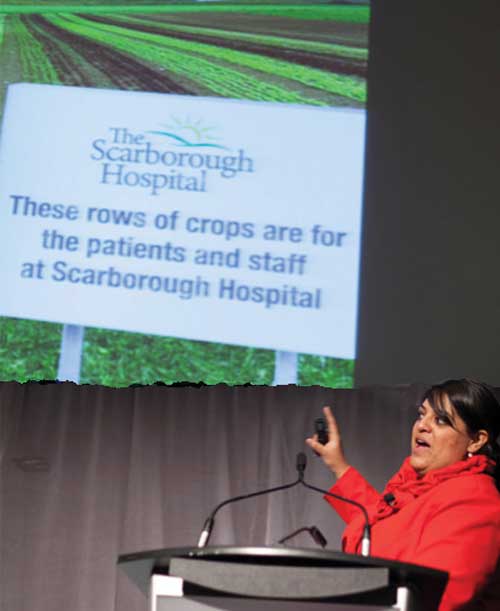

The 2013 Terroir Hospitality Symposium struck me as being the most insightful of all. Arlene Stein spent last summer in Europe to invite several of the continent’s most acclaimed chefs to share their stories, memories, and cultures. They eloquently expressed the joys of simply good food.
I took the opportunity to speak with several of them to determine if there was something we could learn from their farmers who make their ingredients so special. (I was looking for tips to share with my clients.) The answers were not as I expected. The farmers were near enough and friendly enough that they could easily visit or telephone to share what was good to cook. These conversations provided menu ideas with stories to share with servers, who then enchanted customers.
It was only later that I comprehended the essence of what these chefs were sharing with me. Their farmers knew how to cook, and cook well. This is not usually considered to be a skill that farmers need. But upon thinking about this, my most successful farm clients are the ones who understand and appreciate a well-cooked meal. This farmer/chef communication is yet another skill required to build our industry. (In my consulting I also help with this.)
Maybe someone could compose a cookbook (or perhaps prepare a course) designed for farmers? At the symposium Alison Fryer, owner of Toronto’s Cookbook Store, stated that cookbooks are more popular than ever. When she opened her store in 1983 there were about 500 cookbooks published (in English) each year; despite all the free web-recipes there are now about 20,000 published (in all languages) each year. All this interest in good food illustrates there is more to it than mere calories and vitamins!

An announcement of the details for the new Growing Forward suite of agricultural supports has been delayed yet another month. Press releases have stated there will be a focus on “innovation, competitiveness, and market development” and the Growing Your Farm Profits business development programs“ will remain essentially the same”. The details are now scheduled to be released near the end of May. I have not yet heard anything about renewal of the Environmental Farm Plan program. (For my clients awaiting this funding, I will advise you as soon as I learn the details.)
The largest portion of the supports ($100,000 per year for Ontario) will be going to the already announced Risk Management Programs. For my ecological farmer clients, these are still of no value. The growing practices of organic and ecological farmers provide a self-insurance that negates any need to rely on these heavily subsidized insurance policies. Risk Management is one portion of the public money that allows industrial farmers to take great risks to grow cheap food for exports and to compete with heavily subsidized imports.
If $100,000 to support our farmers seems excessive, keep in mind that percentage of Canadian supports are a third of the US and fifth of Europe. Let’s thank our farmers for helping to keep the Canadian economy so buoyant.
Agreements to agree on land transfers to the new Rouge National Urban Park are still being worked on. Progress remains painfully slow; but interest in the incredible possibilities is rapidly growing.
Green Neighbours of Ward 21 have invited William Lishman to show an extended cut of his stunning video about the Rouge agricultural lands. He has invited Geraldine Dempsey to discuss the amazing agricultural activity now going on in the Cuyahoga National Park next to Cleveland. He has also invited me to discuss the vision of an innovative Agri-Food Hub next to Toronto. Please come join us on May 6 at 7:00pm at St. Mathews Church (St. Clair and Bathurst).

I attended the 1988 conference to initiate An Organic System for Canada. This led to a series of meetings that culminated in a definition for “organic” which was quickly accepted by Consumer and Corporate Affairs in 1989. Then the Canadian Food Inspection Agency (CFIA) set out to legally define the word. Little did anyone know that it would then take another 20 years of relentless discussions for the Organic Products Regulations to be proclaimed in 2009.
Given this experience, it is understandable why the CFIA would choose a less demanding process to define “Local Food”. We most often hear about 100km or 100 mile food. But these bring about limitations for those trying to join the spirit of the concept. Ontario’s 50 counties are likewise too small. Ontario’s 15 Tourist Regions make some agronomic and cultural sense. For clarity, practicality, and something consumers understand and support, the proposed provincial Local Food Act defines “local” as within Ontario. (In many ways this is too extensive.) So I think we need to keep the discussion going until we reach some consensus.
On April 4, 2013, the CFIA ordered Bistro Burger Joint in Alliston (ON) to cease calling their meat “local”. The nearest supplier the chef felt could be sufficiently consistent is Field Gate Organics (near Exeter, 200km away). CFIA informed the restaurant that the legal definition of local is from the same or an adjacent “government unit.” The government unit they have chosen to use is Townships or 50km, whichever is less. For this reason Bistro Burger Joint must cease using the term “local beef” on their menus, signs and website. (Catherine Porter wrote about a similar startling order issued to Real Food for Real Kids.)
Since marketing local food is an important part of my consulting work, I called CFIA in Ottawa to learn when (and why) this policy came about. Their response was surprise that CFIA would even be concerned about this. I was then directed to the Ontario office in Guelph where I received the same response. Then I called the Barrie office (which had issued the order) to receive the explanation that CFIA had adopted a 1970’s Food and Drug Regulations definition of “local”. So I went on the CFIA website to find that this definition has indeed been added as part of their labeling requirements. [Who knew?]
This new policy is most unusual. Politicians have carefully explained to me that the function of government is not to lead; but to follow. Rules they make are to acknowledge and clarify the consensus of the public. From all my decades of work promoting “local foods,” I have never heard anyone allude to anything about 50km or “adjacent government units.”
Research from The University of Guelph indicates that in 2008, 77% of Ontarians intended to purchase Ontario grown food if it was readily available and cost no more than imports. Research at Iowa State University indicated that in 2008 the multiplier-effect of local food in regions with smaller farms (such as Ontario) benefits the overall economy 2.6 times as much as imported foods. With an eager market that could significantly benefit all our society, one would think that our governments would start to reduce impediments (such as allowing imports to be sold into Canada for less than they are sold in their own countries [i.e. illegal dumping]) and rebuilding our agricultural infrastructure (such as encouraging our youth to enter agricultural careers [which could be profitable without the competition from illegal dumping]).
The new CFIA definition means that central Toronto will no longer be able to consider the prime agricultural regions near Niagara, Caledon, Bradford or Peterborough as “local”. This will also negate many beneficial policies contained in the proposed Local Food Act. And it ignores the public consensus. Who is driving this campaign to diminish local food? This sinister action against small producers must be stopped!

It was with some misgivings that I decided to attend the Conference Board of Canada’s 2013 Canadian Food Summit to participate in creating their Canadian [Industrial] Food Strategy. My initial observation was who was not there. There were essentially no artisans, chefs, home economists, nutritionists, small farmers, obese or hungry. As in the 1st Summit, any questions about Supply Management were immediately suppressed [because the topic is too controversial].
Even the food industry chief executives were absent. Their underlings were present, but they asked virtually no questions after presentations, I overheard no on-topic discussions between them, and I found it difficult to strike up conversations with them as we waited in food and coffee lineups. Civil society attendees (who had managed to receive reductions in the $1225 fee) asked most of the questions and generally animated the breaks.
Nearly all the plenary speakers advocated agri-food exports, large-scale agri-food processing, and corporate agri-food prosperity. Healthy food, food safety, household food security, and environmental sustainability were afterthoughts. I noted two exceptions:
Other exceptions (notably University of Guelph’s Ralph Martin and 100km’s Paul Sawtell) spoke in Concurrent Sessions, so I could not hear them all. However, the evening before many who should have been invited to the main summit appeared at the Alternate Canadian Food Summit.
I was most eager to attend the final 40-minute session where I would be able to actually see and comment on one element of the Draft Canadian Food Strategy. Normally one would have to “invest” $11,400 annually to see these details; to have input in the planning and decision making one would have to “invest” $50,000 annually!
I chose to see the Environmental Sustainability element. My first thought was that this had been written as a high school assignment. It was both incomplete and repetitive. Upon closer inspection this was somewhat explained by the peculiar assumption stated in its Strategic Challenge. “Sustainability” referred to steady food production and exports; while “environmental” referred to comparing environmental performance with competitor countries. This element was so far off the mark that the participants at my table had no idea where to start.
On my drive home I could only think about the warnings Jane Jacobs presented in her perceptive book Systems of Survival. She divides human ethics into two totally distinct groups:
Throughout human history, whenever one of these groups assumes a function of the other, serious trouble ensues. Creating a Food Strategy is clearly a Guardian [government] function. Traders [business executives] attempting to create a Food Strategy are doomed to fail.
| forward to a friend and suggest signing up to receive this newsletter every month. |